10 best12 String Acoustic Guitarsof December 2025
112M consumers helped this year.
1

Yamaha Fs100C Acoustic Guitar, Natural - Rosewood
YAMAHA

9.7
2

Kadence 12 strings Slowhand Premium Mahogany wood Semi Acoustic Guitar KSH03-12EQ
Kadence

9.4
3

D'Addario EJ16 Acoustic 12-53 Light Guitar Strings made of Phosphor Bronze for Warm, Bright & Balanced Tone
D'Addario

9.2
4

Ernie Ball 12-string 2153 Slinky Acoustic Phosphor Bronze Set .009 - .046
Ernie Ball

8.9
5

D'Addario Bronze Acoustic Guitar Strings_{.010-.050_Light Gauge}85/15 FULL BRIGHT TONE_Stainless Steel Material
D'Addario

8.6
6

D'Addario EJ41 12-String Phosphor Bronze Acoustic Guitar Strings, Extra Light, 9-45
D'Addario

8.3
7

Ernie Ball Earthwood Medium 12-String 80/20 Bronze Acoustic Guitar Strings - 11-28 Gauge
Ernie Ball

8.0
8

Elixir Strings Acoustic Guitar Strings, 6 String, Light POLYWEB Coating
Elixir

7.7
9

D'Addario XS Acoustic Guitar Strings, Phosphor Bronze, Light, 12-53 (XSAPB1253)
D'Addario

7.4
10

D'Addario Guitar Strings - XS Phosphor Bronze Coated Acoustic Guitar Strings - XSAPB1256 - Maximum Life with Smooth Feel & Exceptional Tone - For 6 String Guitars - 12-56 Light Top/Medium Bottom
D'Addario

7.1
Best Reviews Guide Newsletter
Get exclusive articles, recommendations, shopping tips, and sales alerts
Sign up for our newsletter to receive weekly recommendations about seasonal and trendy products
Thank you for subscribing!
By submitting your email address you agree to our Terms and Conditions and Privacy Policy

